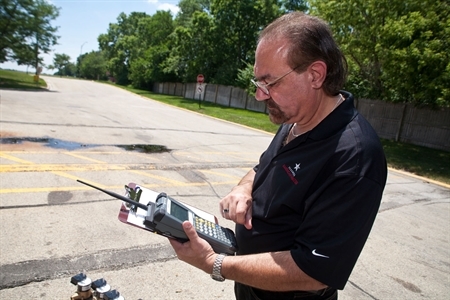
What Our Water's Worth is a campaign led by the Metropolitan Planning Council and Openlands to raise awareness about the value of water in northeastern Illinois and northwestern Indiana.
Not your father's water meter

When one of his customers received a whale of a water bill for more than $21,000, Don Catanese, a 31-year veteran water meter reader, knew something was amiss. Typically, the monthly bill for this industrial user comes in around $3,500.
Catanese’ astute observation was partly due to experience: He began his career with Citizens Utilities, now Illinois American Water (IAW), in 1980, when he walked from house to house in his hip-hugger pants and platform shoes, manually reading each customer’s meter. That was the norm back then, and IAW employed six readers who, just like Catanese, embodied the cliché of a meter reader, getting chased by dogs and questioned by customers all while trying to handwrite readings in a ledger.
Today that image is becoming outdated, as most public and private utilities are moving to automated reading. Not only does automated reading save meter readers from such indignities as ankle-biting dogs, it also provides myriad benefits to both water providers and customers, including greater efficiency, reduced costs, and state-of-the-art technology to capture and analyze critical data.
Continue reading to learn how new meter technology is saving water and money. >>
Read about the future of water meters in the City of Chicago. >>
Read a brief history of water meter technology. >>
Conservation Tips
Check the meter frequently! Being mindful of how much water your household is using can help ensure your water usage matches your actual water needs. You might be using a lot more water than you think.
Perform a leak check. Turn off all the taps in the residence, than look at your meter. If it is still turning, there might be leak. According to the EPA, more than 1.25 trillion gallons of water leak from U.S. homes each year.
Look for the WaterSense label when replacing old toilets, showerheads, and sink faucets. These products perform as well or better than their less efficient counterparts and are 20 percent more water efficient. To test it, track your meter reading before and after installation of WaterSense products and see how much water you save first hand.
Resources
October 2011
www.chicagolandh2o.org
Upcoming events
| Oct 17 | Illinois Green Infrastructure Grant workshop (Chicago) 3:00 PM–4:30 PM |
|---|---|
| Oct 18 | Illinois Green Infrastructure Grant workshop (Elgin) 10:00 AM–11:30 AM |
More upcoming events
Oct. 11: Chicago Does Water Harvesting, 6 to 8 p.m.
Oct. 12: This Blue Planet, with Alexandra Cousteau, 5:30 p.m.
More workshops and other events at chicagolandh2o.org >>
WOWW Factors
3,500 GALLONS PER DAY
A leak as small as 1/8-inch in diameter can waste more than 3,500 gallons of water per day.
30 MILLION GALLONS PER DAY
Full city metering could reduce Chicago’s water consumption by 20 or 30 million gallons a day.
$0
Chicago residents who choose to install a water meter through the MeterSave program receive the meter absolutely free!
What Our Water's Worth is a monthly e-newsletter. Tell us what you think. Email info@chicagolandh2o.org with feedback in the subject.
To subscribe, visit our website at chicagolandh2o.org.

|
Metropolitan Planning Council
140 S Dearborn St | Suite 1400 | Chicago, IL 60603 Phone (312) 922-5616 phone | Fax (312) 922-5619 |
Openlands
25 E. Washington St. | Suite 1650 | Chicago, IL 60602 Phone: 312-863-6250 | Fax 312-427-6251 |
Copyright © 2026. All rights reserved. | info@chicagolandh2o.org
To stop receiving this newsletter visit metroplanning.org/unsubscribe.html?EmailMsgId=143&email=
